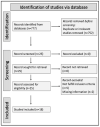Serum Concentrations of Ischaemia-Modified Albumin in Acute Coronary Syndrome: A Systematic Review and Meta-Analysis
- PMID: 35887968
- PMCID: PMC9324639
- DOI: 10.3390/jcm11144205
Serum Concentrations of Ischaemia-Modified Albumin in Acute Coronary Syndrome: A Systematic Review and Meta-Analysis
Abstract
The identification of novel circulating biomarkers of acute coronary syndrome (ACS) may improve diagnosis and management. We conducted a systematic review and meta-analysis of ischaemia-modified albumin (IMA), an emerging biomarker of ischaemia and oxidative stress, in ACS. We searched PubMed, Web of Science, and Scopus from inception to March 2022, and assessed the risk of bias and certainty of evidence with the Joanna Briggs Institute Critical Appraisal Checklist and GRADE, respectively. In 18 studies (1654 ACS patients and 1023 healthy controls), IMA concentrations were significantly higher in ACS (standard mean difference, SMD = 2.38, 95% CI 1.88 to 2.88; p < 0.001; low certainty of evidence). The effect size was not associated with pre-defined study or patient characteristics, barring the country where the study was conducted. There were no significant differences in effect size between acute myocardial infarction (MI) and unstable angina (UA), and between ST-elevation (STEMI) and non-ST-elevation MI (NSTEMI). However, the effect size was progressively larger in UA (SMD = 1.63), NSTEMI (SMD = 1.91), and STEMI (3.26). Our meta-analysis suggests that IMA might be useful to diagnose ACS. Further studies are warranted to compare the diagnostic performance of IMA vs. established markers, e.g., troponin, and to determine its potential utility in discriminating between UA, NSTEMI, and STEMI (PROSPERO registration number: CRD42021324603).
Keywords: ST-elevation myocardial infarction; acute coronary syndrome; acute myocardial infarction; biomarkers; ischaemia-modified albumin; non-ST-elevation myocardial infarction; unstable angina.
Conflict of interest statement
The authors declare no conflict of interest.
Figures








Similar articles
-
Ischemia-modified albumin: is it a promising marker in acute coronary syndrome?BMC Cardiovasc Disord. 2024 Aug 22;24(1):436. doi: 10.1186/s12872-024-04108-2. BMC Cardiovasc Disord. 2024. PMID: 39174920 Free PMC article.
-
Epidemiology and risk factors of patients with types of acute coronary syndrome presenting to a tertiary care hospital in Sri Lanka.BMC Cardiovasc Disord. 2019 Oct 21;19(1):229. doi: 10.1186/s12872-019-1217-x. BMC Cardiovasc Disord. 2019. PMID: 31638908 Free PMC article.
-
Association between serum lipoprotein-associated phospholipase A2, ischemic modified albumin and acute coronary syndrome: a cross-sectional study.Heart Vessels. 2019 Oct;34(10):1608-1614. doi: 10.1007/s00380-019-01403-3. Epub 2019 Apr 8. Heart Vessels. 2019. PMID: 30963302
-
Immature Platelet Fraction and Acute Coronary Syndrome; a Systematic Review and Meta-Analysis.Arch Acad Emerg Med. 2024 Apr 23;12(1):e43. doi: 10.22037/aaem.v12i1.2292. eCollection 2024. Arch Acad Emerg Med. 2024. PMID: 38962365 Free PMC article. Review.
-
Performance of Copeptin for Early Diagnosis of Acute Coronary Syndromes: A Systematic Review and Meta-Analysis of 14,139 Patients.J Cardiovasc Dev Dis. 2021 Dec 27;9(1):6. doi: 10.3390/jcdd9010006. J Cardiovasc Dev Dis. 2021. PMID: 35050216 Free PMC article. Review.
Cited by
-
Association between ischemia-modified albumin (IMA) and peripheral endothelial dysfunction in rheumatoid arthritis patients.Sci Rep. 2024 Feb 17;14(1):3964. doi: 10.1038/s41598-024-54641-5. Sci Rep. 2024. PMID: 38368495 Free PMC article.
-
Association of Ischemia-Modified Albumin (IMA) in Saliva, Serum, and Urine with Diagnosis of Chronic Kidney Disease (CKD) in Children: A Case-Control Study.Med Sci Monit. 2023 Dec 14;29:e942230. doi: 10.12659/MSM.942230. Med Sci Monit. 2023. PMID: 38093614 Free PMC article.
-
The role of ischaemia-modified albumin in the prognosis of acute pancreatitis and its correlation with the NF-κB-mediated inflammatory response.J Int Med Res. 2024 Oct;52(10):3000605241287163. doi: 10.1177/03000605241287163. J Int Med Res. 2024. PMID: 39474645 Free PMC article.
-
Analytical Insights into Methods for Measuring Ischemia-Modified Albumin.Molecules. 2024 Sep 29;29(19):4636. doi: 10.3390/molecules29194636. Molecules. 2024. PMID: 39407566 Free PMC article. Review.
-
Ischemia-modified albumin in rheumatic diseases: A systematic review and meta-analysis.Immun Inflamm Dis. 2024 Jun;12(6):e1324. doi: 10.1002/iid3.1324. Immun Inflamm Dis. 2024. PMID: 38888377 Free PMC article.
References
-
- Gulati M., Levy P.D., Mukherjee D., Amsterdam E., Bhatt D.L., Birtcher K.K., Blankstein R., Boyd J., Bullock-Palmer R.P., Conejo T., et al. AHA/ACC/ASE/CHEST/SAEM/SCCT/SCMR Guideline for the Evaluation and Diagnosis of Chest Pain: A Report of the American College of Cardiology/American Heart Association Joint Committee on Clinical Practice Guidelines. J. Am. Coll. Cardiol. 2021;78:e187–e285. doi: 10.1016/j.jacc.2021.07.053. - DOI - PubMed
-
- Collet J.P., Thiele H., Barbato E., Barthélémy O., Bauersachs J., Bhatt D.L., Dendale P., Dorobantu M., Edvardsen T., Folliguet T., et al. 2020 ESC Guidelines for the management of acute coronary syndromes in patients presenting without persistent ST-segment elevation. Eur. Heart J. 2021;42:1289–1367. doi: 10.1093/eurheartj/ehaa575. - DOI - PubMed
Publication types
Grants and funding
LinkOut - more resources
Full Text Sources

